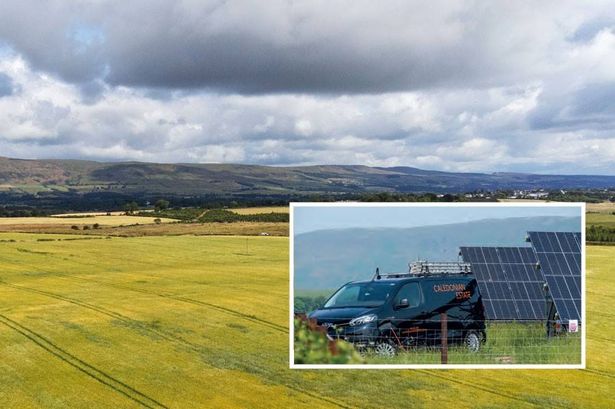Business
Major Solar Farm Construction Nears Completion in Glasgow

A significant solar energy project is nearing completion in Glasgow, marking a pivotal advancement in Scotland’s renewable energy landscape. The solar farm, developed by Caledonian Properties, spans an impressive area equivalent to 83 football pitches on green belt land in Glasgow North, situated near the Union Canal and Possil Marsh. This initiative will be the first ground-mounted solar farm within the city limits and is expected to generate enough electricity to power approximately 6,300 households.
Construction activity has been observable along the canal towpath in recent months, although the site remains concealed behind tall hedgerows. Caledonian Properties, a part of Derwent London, which oversees a vast portfolio of central London properties valued at around £5.2 billion, submitted the planning application for the solar farm in 2021. The project received approval from Glasgow City Council in 2023, culminating in a significant milestone for renewable energy in the region.
Project Scope and Environmental Commitment
Upon completion in 2025, the solar farm at Lochfauld Road is projected to be among the largest in Scotland. According to a statement from Derwent London, the site will host 37,000 solar panels, generating around 18.4 million kilowatt hours of renewable energy. This output represents nearly 50% of the energy consumption of Derwent London’s managed portfolio in London, highlighting the company’s commitment to sustainability.
The development aligns with Glasgow’s city development plan, which identified the project as suitable for green belt development. The planning document notes that it will “bring arable farm land into sustainable use whilst still allowing for sheep grazing.” Most of the site will be landscaped with grass and hedgerows, enhancing the local ecosystem.
Community and Environmental Impact
In addition to energy production, the project incorporates ecological initiatives. Caledonian Properties has already planted native grasses and wildflowers on the site, and a local sheep farmer will graze their flock beneath the solar panels. This holistic approach not only generates renewable energy but also promotes biodiversity and sustainable land use.
The solar farm’s photovoltaic panels will have a maximum height of 3.1 metres (10 feet), with a designated 45-metre buffer zone between the farm and the Possil Marsh Site of Special Scientific Interest. This strategic planning aims to minimize environmental impact while optimizing energy output.
As the project progresses, it has the potential to surpass Scotland’s current largest solar farm, the 5 MW West Strathore solar farm near Glenrothes in Fife. Other solar initiatives, such as the upcoming Bilbo Solar Farm in Aberdeenshire, which aims to produce 36.6 MW, and additional developments at Glasgow Airport and GlaxoSmithKline’s Shewalton Road site in Irvine, indicate a growing commitment to renewable energy across the region.
The Caledonian Solar Farm not only represents a step towards sustainable energy but also underscores the importance of integrating ecological practices within development projects. As Glasgow moves closer to its green energy goals, this solar farm could play a significant role in shaping the future of energy in Scotland.
-

 Health3 months ago
Health3 months agoNeurologist Warns Excessive Use of Supplements Can Harm Brain
-

 Health3 months ago
Health3 months agoFiona Phillips’ Husband Shares Heartfelt Update on Her Alzheimer’s Journey
-

 Science1 month ago
Science1 month agoBrian Cox Addresses Claims of Alien Probe in 3I/ATLAS Discovery
-

 Science1 month ago
Science1 month agoNASA Investigates Unusual Comet 3I/ATLAS; New Findings Emerge
-

 Science4 weeks ago
Science4 weeks agoScientists Examine 3I/ATLAS: Alien Artifact or Cosmic Oddity?
-

 Entertainment4 months ago
Entertainment4 months agoKerry Katona Discusses Future Baby Plans and Brian McFadden’s Wedding
-

 Science4 weeks ago
Science4 weeks agoNASA Investigates Speedy Object 3I/ATLAS, Sparking Speculation
-

 Entertainment4 months ago
Entertainment4 months agoEmmerdale Faces Tension as Dylan and April’s Lives Hang in the Balance
-

 World3 months ago
World3 months agoCole Palmer’s Cryptic Message to Kobbie Mainoo Following Loan Talks
-

 Science4 weeks ago
Science4 weeks agoNASA Scientists Explore Origins of 3I/ATLAS, a Fast-Moving Visitor
-

 Entertainment4 months ago
Entertainment4 months agoLove Island Star Toni Laite’s Mother Expresses Disappointment Over Coupling Decision
-

 Entertainment3 months ago
Entertainment3 months agoMajor Cast Changes at Coronation Street: Exits and Returns in 2025









